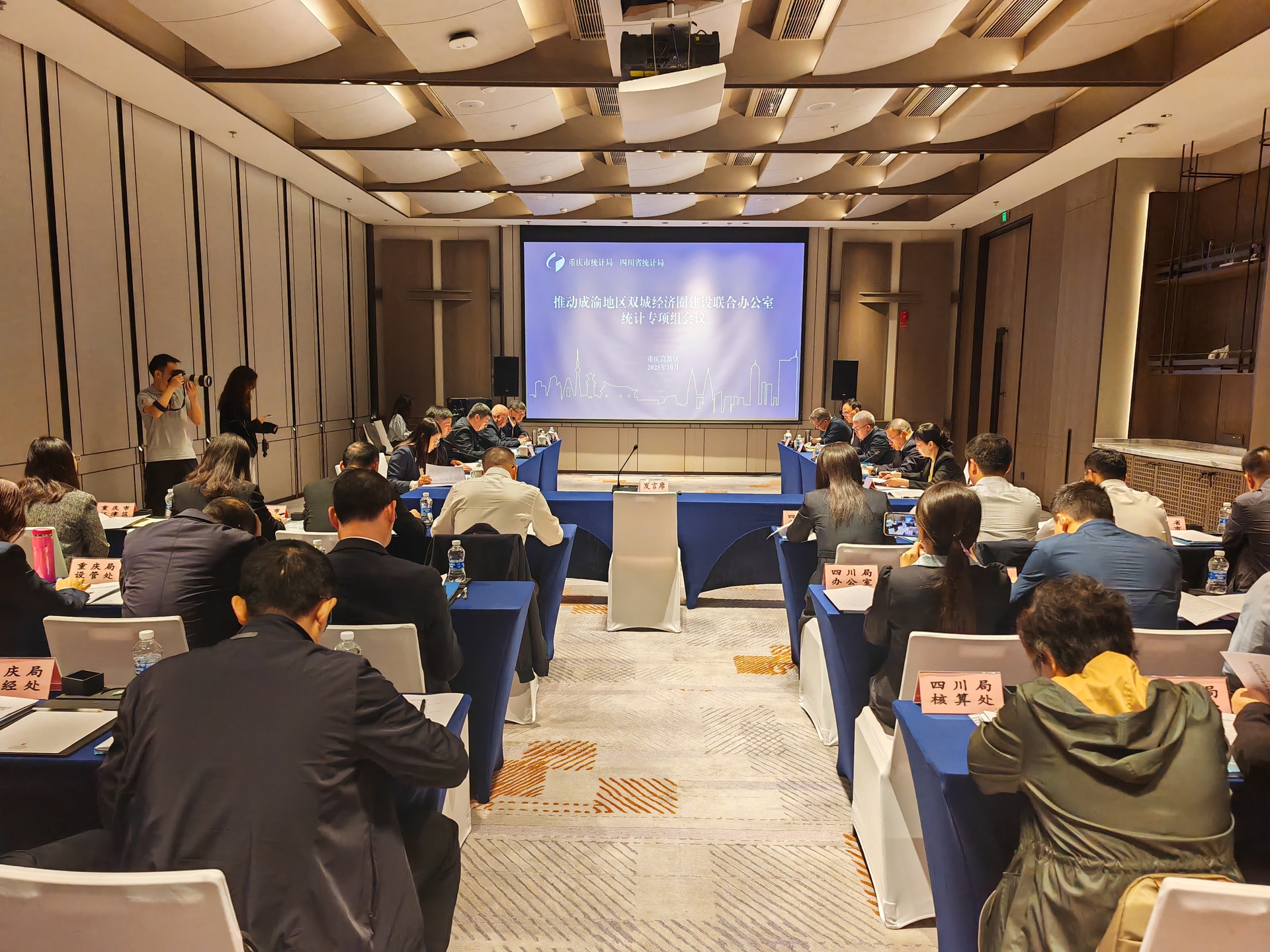The joint office for promoting the Chengdu-Chongqing economic circle construction held a special statistics working group meeting. The meeting reviewed statistical work achievements over the past five years in the Chengdu-Chongqing economic circle construction and discussed arrangements for the next phase of work.
Over the past five years, Sichuan and Chongqing have jointly promoted the Chengdu-Chongqing economic circle construction, achieving substantial progress and delivering excellent economic results. Data shows that the economic output of the Chengdu-Chongqing economic circle increased from less than 6.4 trillion yuan in 2019 to 8.7 trillion yuan in 2024, with its share of the national economy rising from 6.3% to 6.5% and accounting for 30.3% of western China’s total. The average annual growth rate reached 5.4%, 0.5 percentage points higher than the national average.
Additionally, the per capita GDP of the Chengdu-Chongqing economic circle reached new milestones, rising from 65,000 yuan in 2019 to over 70,000 yuan in 2021, exceeding 80,000 yuan in 2023, and reaching 88,000 yuan in 2024. The average annual growth rate was 5.3%, 0.5 percentage points higher than the national average. The economic strength, development vitality, and regional competitiveness of the Chengdu-Chongqing economic circle have significantly improved, enhancing its supporting role in advancing western development and national high-quality development.
Over the past five years, the statistical systems of Sichuan and Chongqing have achieved new breakthroughs in mechanism coordination, jointly establishing a special statistics working group and issuing work rules. Under the National Bureau of Statistics’ leadership group for regional major development strategy statistical monitoring, an office for statistical monitoring of the Chengdu-Chongqing economic circle construction was established, further improving the working mechanism.
Monitoring system construction reached new heights. The statistical systems of both regions jointly promoted the approval and official issuance of the “Statistical Monitoring System for Chengdu-Chongqing Economic Circle Construction (Trial)” by the National Bureau of Statistics, achieving a leap from local exploration to national standards, marking an important milestone.
Statistical research cooperation deepened. The statistical systems successfully held four statistical science seminars on the Chengdu-Chongqing economic circle, forming multiple beneficial consensuses and innovative suggestions. They jointly conducted several key research projects and surveys, providing important theoretical support and decision-making references for the economic circle’s construction.
As the Chengdu-Chongqing economic circle enters a new five-year planning period, the meeting required statistical systems to focus on improving working mechanisms, enhancing statistical service efficiency, and expanding exchange and cooperation dimensions.
During the meeting, statistical departments reported on five years of statistical research cooperation and statistical monitoring of the economic circle construction since 2024. They introduced statistical monitoring for key industrial chain development and the “Government-Business One-Click Access” system, demonstrating the “Government-Business Intelligent Management for Enterprise Registration and Scale Upgrade.” Presentations were also made on the fourth national agricultural census pilot work and the national 1% population sample survey pilot work.
Chengdu-Chongqing economic circle
The Chengdu-Chongqing economic circle is a major regional development strategy in southwestern China, officially launched in 2021. It aims to transform the twin metropolises of Chengdu and Chongqing and their surrounding areas into a powerful economic engine and a key growth pillar for the country’s interior. Historically, this Sichuan Basin region has long been a populous and agriculturally vital area, with its modern integration building on decades of industrial development.
Sichuan
Sichuan is a southwestern Chinese province renowned for its distinctive and spicy cuisine, as well as its unique teahouse culture. Historically, it was the location of the ancient Shu and Ba kingdoms and later became a major cultural and economic center, famously symbolized by the Leshan Giant Buddha carved during the Tang Dynasty. The province is also a critical habitat for giant pandas and features dramatic natural landscapes, including the Jiuzhaigou Valley.
Chongqing
Chongqing is a major metropolitan center in southwestern China, strategically located at the confluence of the Yangtze and Jialing Rivers. Historically, it served as the provisional capital of China during the Second Sino-Japanese War (1937-1945). Today, it is renowned as a sprawling megacity and a vital industrial and economic hub for the upper Yangtze region.
National Bureau of Statistics
The National Bureau of Statistics (NBS) is China’s principal agency responsible for collecting, compiling, and publishing statistical data on the nation’s economy, population, and society. It was established in its modern form in 1952 to support central planning and policy-making. Today, the NBS provides crucial official data, such as GDP and inflation figures, that are closely watched by both domestic and international observers.
western China
Western China is a vast, diverse region historically shaped by the ancient Silk Road, which facilitated trade and cultural exchange for centuries. It encompasses arid deserts, towering mountain ranges like the Pamir, and is home to many ethnic minority groups, including the Uyghurs and Tibetans. Historically, it was not always under direct Chinese control, with parts like Xinjiang and Tibet being incorporated into the Chinese empire at different periods.
fourth national agricultural census
The Fourth National Agricultural Census is a large-scale statistical survey conducted by governments to collect comprehensive data on a country’s agricultural sector. It typically gathers information on land use, crop production, livestock, and farm economics. These censuses are crucial for informing national agricultural policies and tracking changes in the rural economy over time.
national 1% population sample survey
The “national 1% population sample survey” is a large-scale demographic survey conducted by China to collect detailed data on population structure, employment, education, and housing. It serves as a crucial supplement to the full national census, providing more frequent and flexible data to inform government policy and social planning.
Government-Business One-Click Access system
The Government-Business One-Click Access system is a digital platform launched by the Vietnamese government to streamline administrative procedures for businesses. It was established to reduce bureaucracy and improve the business environment by allowing companies to submit documents and access public services online through a single portal. This initiative represents a key part of Vietnam’s national digital transformation efforts to enhance transparency and efficiency in government-business interactions.




